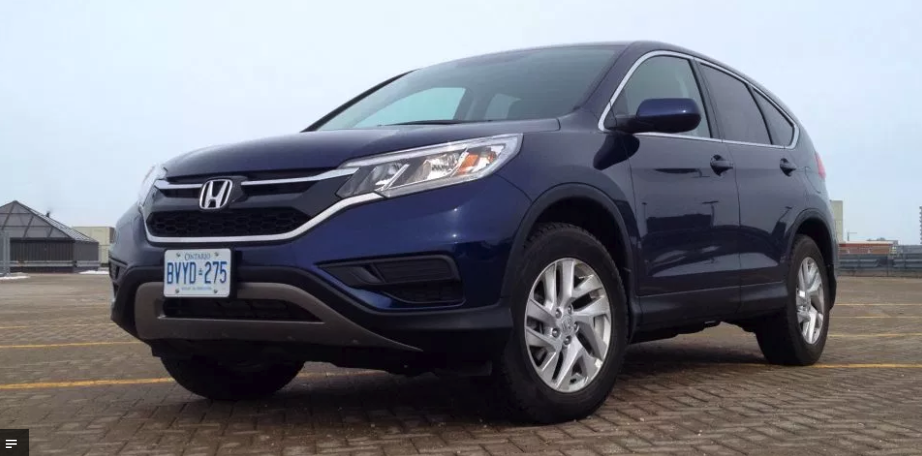Long-Term Test: 2015 Honda CR-V SE AWD – Part 1

Story and photo by John LeBlanc
The numbers don’t lie. If you’re in the throes of new car shopping, chances are you’re considering a compact crossover.
With sales up over 50 percent in the past decade, compact crossovers make up about one-third of all light truck sales in Canada, making these car-based tall wagons the second-largest new car segment in the country, right behind compact cars. That is why we chose one of the most popular small crossovers on the market, the Honda CR-V, for our second long-term 60-day test drive.
While many still mourn the passing of the station wagon as a staple of family transportation, the rise of the compact crossover is a result of the right product at the right time. Just as station wagons mirrored the horizontal proportions of the typical post-modern suburban bungalow, the taller and shorter post-millennial compact crossover mirrors the space efficiency of an urban townhouse. Here in Canada, where fear advertising still works, many buyers have become addicted to the perceived safety of traction at all four wheels — a feature unavailable on your parents’ Ford LTD Country Squire wagon.
Although it wasn’t called a “crossover” at the time, the first Honda CR-V was one of those newfangled vehicles that helped put a nail in the coffin for station wagons as a staple of family transportation. Based on contemporary Honda Civic Shuttle AWD wagon mechanicals, the 1997 CR-V was the Japanese automaker’s answer to larger SUV rivals of the time, like the Ford Explorer.
The original CR-V may have been relatively tiny and underpowered, but buyers loved the Honda’s easy-to-drive nature, decent fuel economy, slightly taller ground clearance and terrific build quality and reliability. So much so, you don’t have to drive far in most Canadian cities to find a first-gen 1997 to 2001 model still performing admirably.
Almost two decades later and the CR-V has become firmly entrenched on our roads. In fact, the Honda compact crossover is more popular than ever. Sales last year in Canada were up 12%, to 37,684 units, making it Honda Canada’s second-best selling vehicle, right behind the best-selling passenger car in the country, the Civic.
The current, fourth-generation CR-V went on sale in Canada for 2012. Yet an incredibly crowded and competitive segment means Honda’s has seen fit to make substantial upgrades to its CR-V for 2015. Refreshed front and rear styling with projector-beam headlights and added chrome, quieter interior with more soft plastic materials and upgraded infotainment, retuned suspension for tighter handling and better brakes, plus a host of new dynamic safety features on the higher end models, have all been added to keep the CR-V neck-and-neck with sales rivals like the Toyota RAV4 and Ford Escape.
Over the next two months, we won’t be testing the fully loaded $38,313 (all prices include freight and pre-delivery inspection fees) 2015 CR-V Touring. Instead, we’ll be evaluating what we think will end up being the CR-V trim line most Canadians will buy: the $31,663 SE AWD.
Over the base, $27,718 CR-V LX-FWD – which already comes well-equipped with features such as heated front seats, rearview camera, Bluetooth connectivity, four-speaker 160-watt AM/FM/CD audio system, High-Definition Multimedia Interface infotainment system, Siri Eyes Free compatibility and more – our SE AWD adds traction at all four wheels, keyless entry with push-button start, centre console bin, body-coloured power exterior mirrors, front wiper de-icer, 17-inch alloy wheels and a few other amenities like HondaLink Assist Automatic Emergency Response System and two more speakers in the sound system.
Such additions are nice, but the main upgrade that has Honda saying the 2015 CR-V has received “the most significant mid-model cycle refresh” in the automaker’s history can be found underneath its flashier sheet metal.
It’s been no secret that the Japanese automakers are playing catch-up when it comes to the latest in engine and transmission technologies. While we’ll have to wait until the next generation CR-V to get Honda’s forthcoming 1.5-litre direct-injected and turbocharged four-cylinder gas engine slated for the all-new 2016 Civic family, the 2015 CR-V gets the direct-injected “Earth Dreams” 2.4L four-cylinder and continuously variable transmission combination from the Accord sedan as an interim move.
Although its 185 horsepower rating is the same as last year’s four-banger with the same displacement, power in the new 2.4 now peaks 600 rpm lower at 6,400, while torque is up to 181 lb.-ft. from 163. Now, in the 2015 CR-V, getting from a standstill to 100 km/h takes roughly 7.7 seconds — a 1.1-second improvement over the outgoing 2014 model that came with a five-speed automatic.
Not only is the 2015 CR-V quicker, but it’s also more frugal. According to Honda, the compact crossover gets improved fuel consumption estimates of 8.6 L/100 kilometres in the city and 6.9 on the highway for FWD models, while AWD models come in at 9.1 city and 7.2 for the AWD models. Those are improvements of 1.7 and 0.8 L/100 km for FWD models, and 1.5 and 0.7 L/100 km for AWD CR-Vs, respectively, over 2014 models. So far, our CR-V SE AWD tester has been averaging 10.8 L/100 kilometres during the last few weeks of winter driving conditions.
In our first 60-day test drive, we asked if a minivan like the 2015 Kia Sedona could still be relevant for family transportation. Based on the segment’s popularity, though, we already know how relevant a compact crossover is to post-millennial Canadian new car buyers. The question we have is: How well does the Honda stack up in one of the most popular and competitive new vehicle markets in Canada?
Good thing we’ll have another six weeks to find out.





![[del.icio.us]](https://www.straight-six.com/wp-content/plugins/bookmarkify/delicious.png)
![[Digg]](https://www.straight-six.com/wp-content/plugins/bookmarkify/digg.png)
![[Facebook]](https://www.straight-six.com/wp-content/plugins/bookmarkify/facebook.png)
![[Google]](https://www.straight-six.com/wp-content/plugins/bookmarkify/google.png)
![[Reddit]](https://www.straight-six.com/wp-content/plugins/bookmarkify/reddit.png)
![[StumbleUpon]](https://www.straight-six.com/wp-content/plugins/bookmarkify/stumbleupon.png)
![[Twitter]](https://www.straight-six.com/wp-content/plugins/bookmarkify/twitter.png)
![[Email]](https://www.straight-six.com/wp-content/plugins/bookmarkify/email.png)